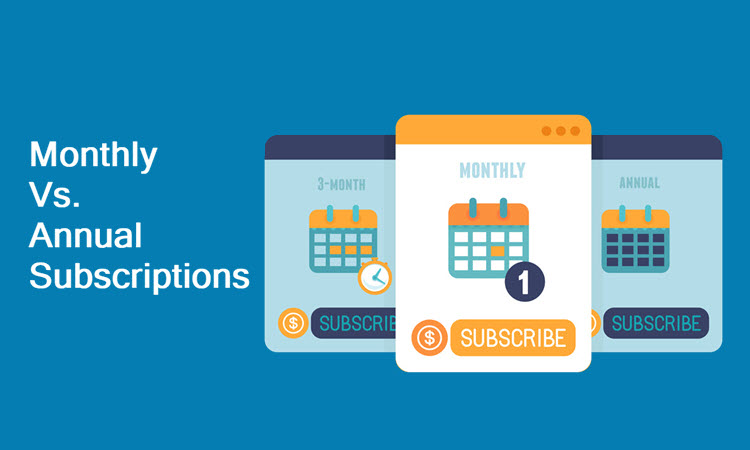SaaS companies and other subscription-based businesses typically opt for either monthly or annual subscriptions.
Each of these options brings specific pros and cons, depending on the business's objectives.
In this article, we’ll compare monthly vs. annual subscriptions to help merchants decide which of these options to use.
Annual vs. Monthly Subscription: Key Takeaways

Annual subscriptions require subscribers to pay once a year for services they use all year long.
Monthly subscriptions require subscribers to make monthly payments for provided products or services.
Typically, both annual and monthly subscriptions renew automatically. The service and the recurring payments occur based on the preselected billing plan until the subscriber cancels the subscription.
| Monthly Subscriptions | Annual Subscriptions | |
|---|---|---|
| Pros | Higher customer acquisition rate Faster asset generation Ease of use Improved business reputation |
Predictable revenue Long-term customer retention Further investments Customer savings |
| Cons | Potential churn rate Unpredictable cash flow |
Repels some customers Costly onboarding procedure |
Monthly Subscription Model: Pros and Cons

The monthly subscription model is popular among businesses of various sizes operating in different niches. Yet, the pros that work for one business turn out to be cons for another. Let’s list the main pros and cons of this subscription business model.
Monthly Subscriptions Pros
- Higher customer acquisition rate. Monthly subscriptions are more enticing for customers who don't know how long they will be using subscription-based services. They’re a practical choice for startups that want to generate more customers in the beginning.
- Faster asset generation. Newly launched subscription-based businesses using monthly subscriptions attract more customers and, consequently, more assets. A new business has a better chance of ensuring regular income from day one.
- Ease of use. The simplicity of the monthly subscription model is beneficial for both merchants and customers. Subscribers pay their fees every month, while business owners seamlessly provide arranged services.
- Improved business reputation. Monthly subscriptions attract more subscribers, which means more customers spreading the word about the brand. In turn, the number of potential new subscribers grows. Also, potential investors pay more attention to companies with more subscribers.
Monthly Subscriptions Cons
- Potential churn rate. Subscribers paying services on a monthly basis can cancel their subscriptions at any time, leading to a higher churn rate.
- Unpredictable cash flow. It’s challenging to make long-term plans if you don’t know how much money you’ll be making in the long run.
Annual Subscription Model: Pros and Cons

The annual subscription model brings unique advantages and disadvantages, different from those of monthly subscriptions.
Annual Subscriptions Pros
- Predictable revenue. Businesses that receive annual subscriptions from customers know the exact amount of money they’ll have at their disposal within one year. Annual subscriptions help businesses plan their long-term budgets and investments.
- Long-term customer retention. Annual subscriptions stay with the business for a minimum of 365 days. You have a lot of time to nurture that customer and make sure they renew their subscription.
- Further investments. Subscription-based businesses that receive annual subscriptions have more assets to work with. They can make further investments with that money and improve the value proposal of their services and products.
- Customer savings. For customers, opting for an annual subscription means saving money compared to paying 12 monthly subscriptions.
Annual Subscriptions Cons
- Repels some customers. For some customers, paying a year-long subscription up front is too much. While they might pay for several months, they probably won’t subscribe at all if only given the option of an annual subscription.
- Costly onboarding procedure. The onboarding procedure for customers paying an annual subscription is more expensive for business owners. Also, if the contract is cancelled while the yearly subscription is still active, the entire process is more complicated for the sales team.
Research different subscription pricing models as well. This will help you get the most of your subscription business.
Which One to Choose?
When it comes to monthly vs. annual subscriptions, it all comes down to business goals and capabilities.
If you are just starting a subscription business, start with monthly subscriptions. One month is enough time for customers to try the products and services. If they see value in the services provided, they’ll become loyal subscribers.
On the other hand, annual subscriptions are a better choice for established brands that sell well-known products. In this case, subscribers know what to expect. It’s more likely they’ll pay annual subscriptions to ensure receiving trustworthy products from a renowned brand.
Have you ever wondered what’s the difference between subscription and membership business models?
How to Use Both

New businesses are more likely to benefit from monthly subscriptions. However, this doesn’t mean that they should completely leave out the option of annual subscriptions.
For instance, give subscribers an option to switch from a monthly subscription to an annual subscription plan. Highlight how much money they can save per year if they pay an annual subscription. It’s recommended that the annual subscription is 15-20% cheaper than 12 monthly subscriptions.
Established businesses with popular services and products should offer monthly and annual subscriptions to all their subscribers. Doing so opens several streams of revenue and meets various customers’ needs.
Conclusion
There’s no straightforward winner when it comes to monthly vs. annual subscriptions.
Subscription-based businesses should consider both options and measure which one works better for their objectives. The explanations and examples from this guide are here to facilitate that decision-making process.
Next, read how a tiered pricing model helps subscription businesses acquire more subscribers. And if you want to learn more about monthly subscription, make sure to check Pay-as-You-Go Vs. Monthly Subscription Billing.
